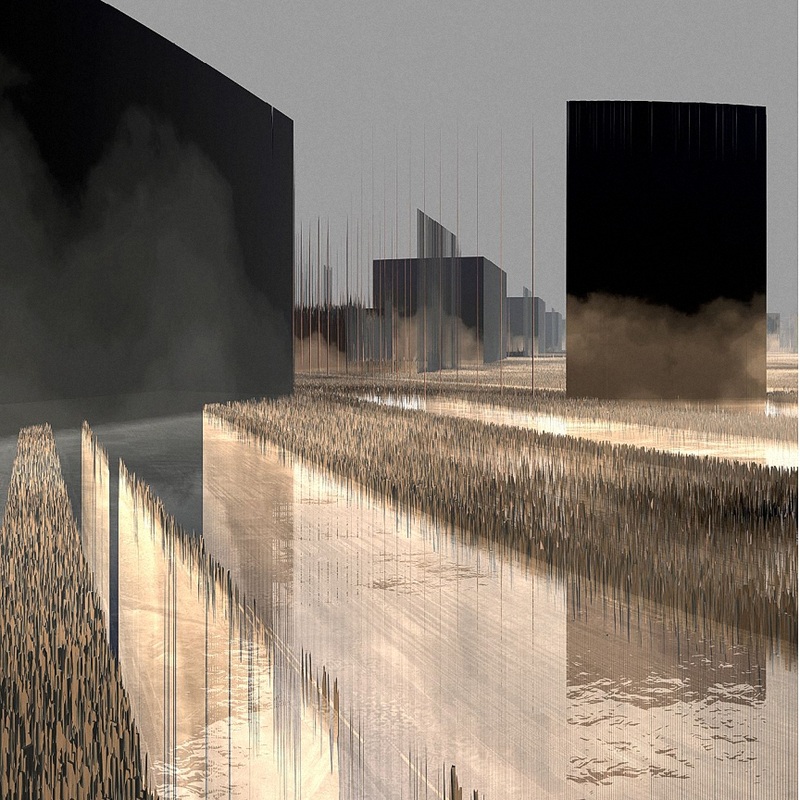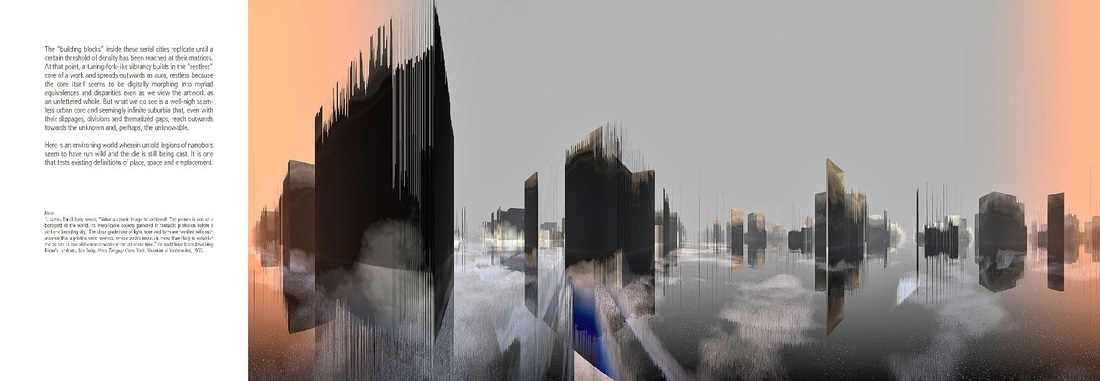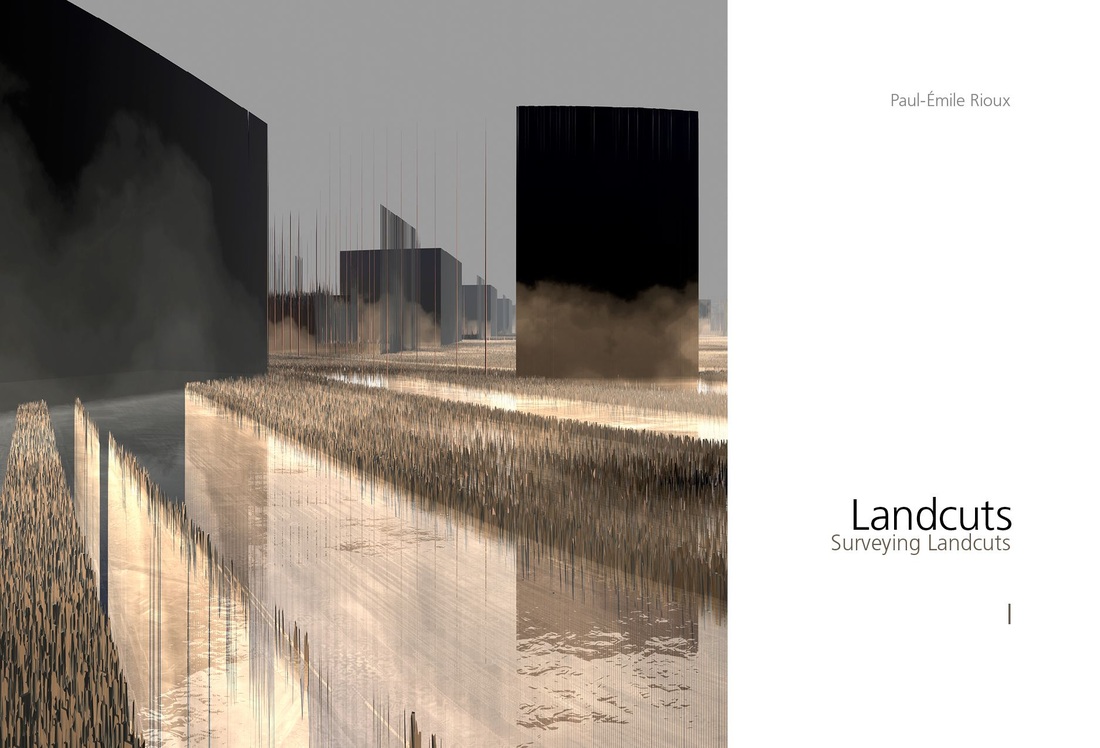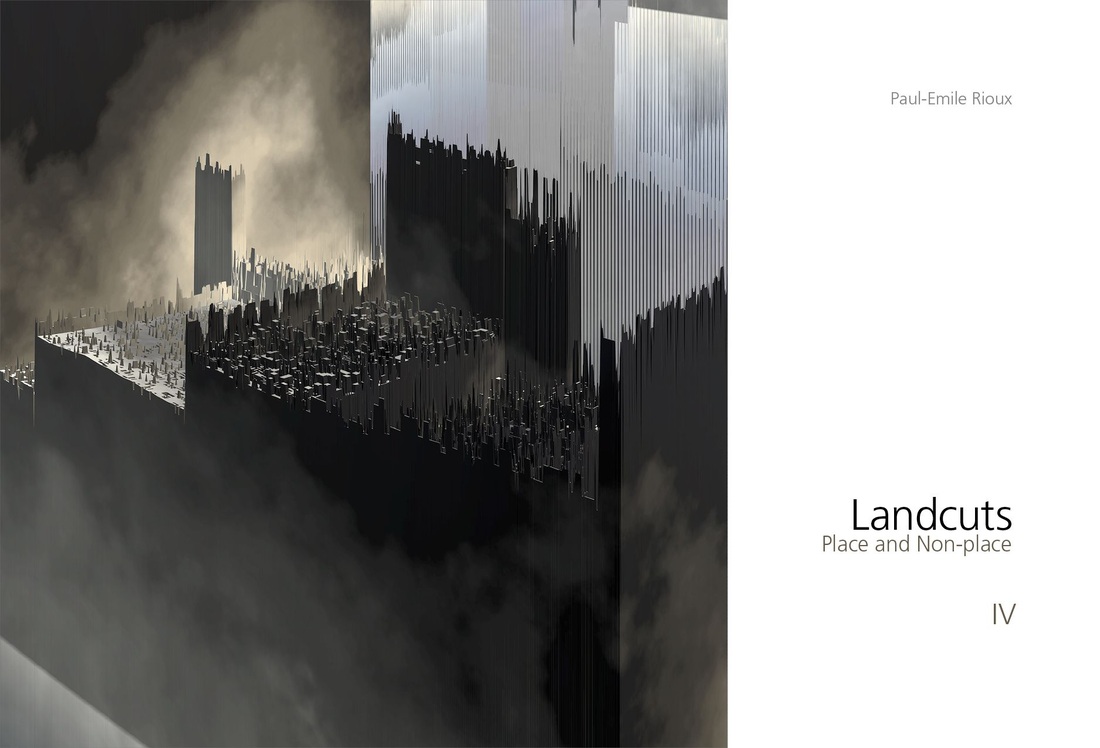“Suppose you think of an organism as being like a computer graphic that is generated from some program. Or think of an oak tree as being the output of a program that was contained inside the acorn. The genetic program is in the DNA molecule. Instead of calling it software like a computer program, we call it wetware because it’s in a biological cell where everything is wet. Your software is the abstract information pattern behind your genetic code, but your actual wetware is the physical DNA in a cell.”
Rudy Rucker, R. U. Sirius, and Queen Mu, eds., The Mondo 2000 User’s Guide.
Rudy Rucker, R. U. Sirius, and Queen Mu, eds., The Mondo 2000 User’s Guide.
Text: James D Campbell, 2014
In his images of Landcuts (comprising the interrelated series The City, Downtown and The Suburb), Paul-Émile Rioux is creating a brave new metamorphic world of habitat and inhabitation for the twenty-first century. Indeed, Rioux broaches a powerful critique even as he builds future worlds of tiered signs that may seem purely utopian and exhilarating on first viewing but which may in fact be profoundly dystopian. As we stand on the threshold of these landcuts, they lay a cunning trap for us. We are seduced into projecting within their infinity grids. We perceive them as harbingers of total colonization, and it is not long before we are submersed and swept away into uncharted depths.
The recent works seem to have been cut whole cloth from Rioux’s forebrain, conjured wholesale as though through implanted wetware from direct and ongoing neural input. These are remarkably holistic images: seamless, dimensionally rich and layered wholes into which we project with alacrity. They have a sweepingly alien cast that reminds us of the best speculative fiction about the cities of the future. They also cross borders of genre, blur distinctions between nature and culture and cultural architectonic, and effortlessly subvert from within.
The recent works seem to have been cut whole cloth from Rioux’s forebrain, conjured wholesale as though through implanted wetware from direct and ongoing neural input. These are remarkably holistic images: seamless, dimensionally rich and layered wholes into which we project with alacrity. They have a sweepingly alien cast that reminds us of the best speculative fiction about the cities of the future. They also cross borders of genre, blur distinctions between nature and culture and cultural architectonic, and effortlessly subvert from within.
Rioux, like contemporary abstract painters such as David Blatherwick and Michel Daigneault, poses the question of telematic connectedness and viral interplay while at the same time foregrounding formal invention and semiotic play. Unlike those painters, however, Rioux exists squarely at the center of the digital, or digimorphic matrix. His works have such an order of internal logic that we feel we should have seen their kin before. In fact, they have no antecedents, which makes their allure all the stronger and more compelling.
Upon first seeing them, one might think of Yves Tanguy’s masterwork Multiplication of the Arcs (1954) although there are no stylistic similarities whatsoever. [1] However, it is true that the work of both artists speaks to the limitless plasticity of the human mind. In any case, Rioux’s work belongs as much to painting as it does to film and photography, and they certainly highlight and work from, if not Surrealism, the iteration of simplicity upon which all modern computing is based. The monolithic integers that populate these works—geometric structures not unlike skyscrapers and simply vast in number—emulate the extraordinary computational power of electrified binary numerics. In so doing, they reach an nth degree of formal complexity. These are integers of infinity that possess a strange grandeur and yield, for the viewer, an epic sense of arrival on the threshold. What we are given seems upon first inspection but a fragment of an endlessly iterated formal whole, a planet-sized city of machine constructs wherein the embodied viewer may well imagine a human factor not actually given. But what we do see is a well-nigh seamless urban core and seemingly infinite suburbia that, even with their slippages, divisions and thematized gaps, reach outwards towards the unknown and, perhaps, the unknowable. Here is an environing world wherein untold legions of nanobots seem to have run wild and the die is still being cast. It is one that tests existing definitions of place, space—and emplacement.
Upon first seeing them, one might think of Yves Tanguy’s masterwork Multiplication of the Arcs (1954) although there are no stylistic similarities whatsoever. [1] However, it is true that the work of both artists speaks to the limitless plasticity of the human mind. In any case, Rioux’s work belongs as much to painting as it does to film and photography, and they certainly highlight and work from, if not Surrealism, the iteration of simplicity upon which all modern computing is based. The monolithic integers that populate these works—geometric structures not unlike skyscrapers and simply vast in number—emulate the extraordinary computational power of electrified binary numerics. In so doing, they reach an nth degree of formal complexity. These are integers of infinity that possess a strange grandeur and yield, for the viewer, an epic sense of arrival on the threshold. What we are given seems upon first inspection but a fragment of an endlessly iterated formal whole, a planet-sized city of machine constructs wherein the embodied viewer may well imagine a human factor not actually given. But what we do see is a well-nigh seamless urban core and seemingly infinite suburbia that, even with their slippages, divisions and thematized gaps, reach outwards towards the unknown and, perhaps, the unknowable. Here is an environing world wherein untold legions of nanobots seem to have run wild and the die is still being cast. It is one that tests existing definitions of place, space—and emplacement.
|
|












